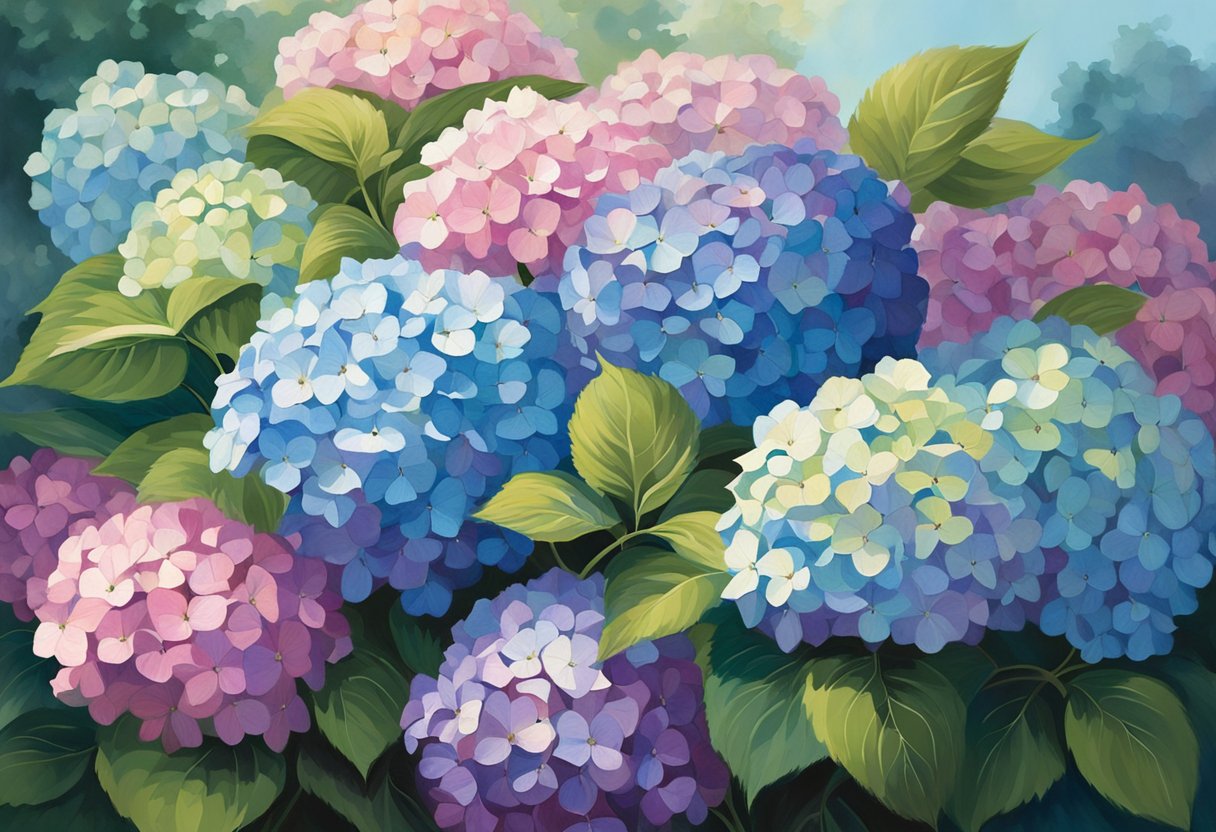Hydrangeas are a stunning addition to any garden, known for their lush, voluminous flower heads that burst with color throughout the growing season. These deciduous shrubs offer a variety of shapes and sizes, ranging from small compact plants to larger species that can dwarf the average fence line. My experience with these flowers has shown me that their appeal lies not just in the colorful blooms, but also in their ability to change color based on the soil’s acidity.

While the exact appearance of a hydrangea can vary among the different types, most share certain characteristics that make them instantly recognizable. Their flowers cluster into two main arrangements: mophead, with large, round flower heads resembling pom-poms, and lacecap, with flatter flower heads consisting of small, fertile flowers surrounded by larger, sterile ones. The range of colors is broad, with blues, pinks, whites, and even purples gracing gardens, depending on the cultivar and soil chemistry.
The leaves of hydrangeas are another telltale sign of their identity. These generally large, toothed leaves create a lush backdrop for the flowers and can range from bright green to deeper shades. In the fall, both flowers and leaves can take on a different hue, adding to the visual interest of these plants. As an avid gardener, I’ve always found hydrangeas to be a rewarding presence, thanks to the fullness and life they bring to my garden from spring to fall.
Selecting the Right Hydrangea for Your Garden
Choosing the correct hydrangea for your garden hinges on understanding the plant’s sunlight, soil needs, and the unique traits of each variety. My focus here will guide you to make an informed decision to ensure a thriving and beautiful hydrangea display.
Understanding Sunlight and Shade Requirements
Soil Preferences and Planting Tips
💥 Soil is pivotal for hydrangea health
Soil should be rich, porous, and well-draining. The pH level of the soil influences the color of some hydrangeas like the bigleaf—acidic soil can lead to blue flowers, while alkaline favors pink hues. I ensure to plant hydrangeas in spring or fall and give them space—about 3 to 10 feet apart depending on the species—so their roots can spread out.
Hydrangea Varieties and Their Distinctive Features
| Variety | Color | Size | Hardiness Zones |
|---|---|---|---|
| Bigleaf Hydrangea | Blue, Pink, White | 3-6 ft tall | 5-11 |
| Smooth Hydrangea | White | 3-5 ft tall | 3-9 |
| Oakleaf Hydrangea | White, Red | 4-6 ft tall | 5-9 |
| Panicle Hydrangea | White, Pink | 8-15 ft tall | 3-8 |
| Climbing Hydrangea | White | 30-40 ft tall | 4-7 |
Every hydrangea variety has distinctive flower shapes and foliage. The lacecap hydrangea has delicate, flat flower heads, and the mophead hydrangea is known for its large, rounded blooms. When I choose, I consider these features alongside the garden’s aesthetic to achieve the desired look.
Cultivating a thriving hydrangea requires attention to watering, soil nutrients, pruning practices, and seasonal adjustments. In my experience, adhering to specific care guidelines promotes healthy growth and vibrant blooms.
Watering and Nutrient Requirements
Keeping hydrangeas appropriately watered is crucial—too much or too little can be detrimental. I ensure the soil is consistently moist without being waterlogged. Well-drained soil is vital to prevent root rot.
When it comes to nutrients, I incorporate organic matter into the soil upon planting and use a balanced, slow-release fertilizer to feed my hydrangeas in spring. The soil pH directly affects flower color—a more acidic soil (pH 5.5-6.5) yields blue flowers, while alkaline soil brings out pink hues.
Pruning Techniques for Optimal Growth
Pruning is pivotal for encouraging hydrangeas to grow robust and produce ample blooms. I prune my hydrangeas based on their specific growth patterns—some flower on old wood, while others bloom on new growth.
💥 Remember to prune after blooming to avoid cutting off next season’s buds. Deadheading spent flowers can also promote further blooming.
Seasonal Considerations for Hydrangea Health
Seasonal changes have a significant impact on hydrangea care. I protect my plants before winter by applying a generous layer of mulch to insulate the roots. This also helps to keep the ground temperature stable.
Avoid fertilizer application in late summer as new growth can be damaged by frost.
In the spring, I inspect my hydrangeas and remove any dead or damaged canes to encourage new growth. As the weather becomes warmer, I keep an eye on the watering needs as the plant’s demands will increase.
Hydrangea Color, Blooms, and Design
Hydrangeas offer a spectacular array of colors and blooms that vary depending on several factors including soil pH. Their versatility in design is appreciated by gardeners and floral designers alike, boasting flower heads that range from the flamboyant mophead to the delicate lacecap.
Influencing Flower Color and pH Levels
| pH Level | Below 5.5 | 5.5 to 6.5 | Above 6.5 |
|---|---|---|---|
| Hydrangea Color | Blue | Purple | Pink |
Designing with Different Hydrangea Colors and Forms
💥 Design Aesthetics
Hydrangeas are not just about color; their blooms and leaves bring structure and texture to gardens and floral compositions. I prefer using bigleaf hydrangeas for a bold statement due to their large, vibrant flower heads. The mophead hydrangeas, with their full, round blooms, create an impactful visual presence. Conversely, the lacecap hydrangeas, with their flatter bloom structure, add a subtle elegance to garden spaces.
When designing, I think about the color transitions throughout the seasons. Green blooms emerge first, often turning to the spectrum of blue, purple, or pink as they mature. The possibility of playing with these colors to complement or contrast other garden elements makes hydrangeas particularly valuable in landscape design. Their leaves, sizable and typically bright green, also contribute to the fullness and lushness of garden compositions or floral arrangements.












